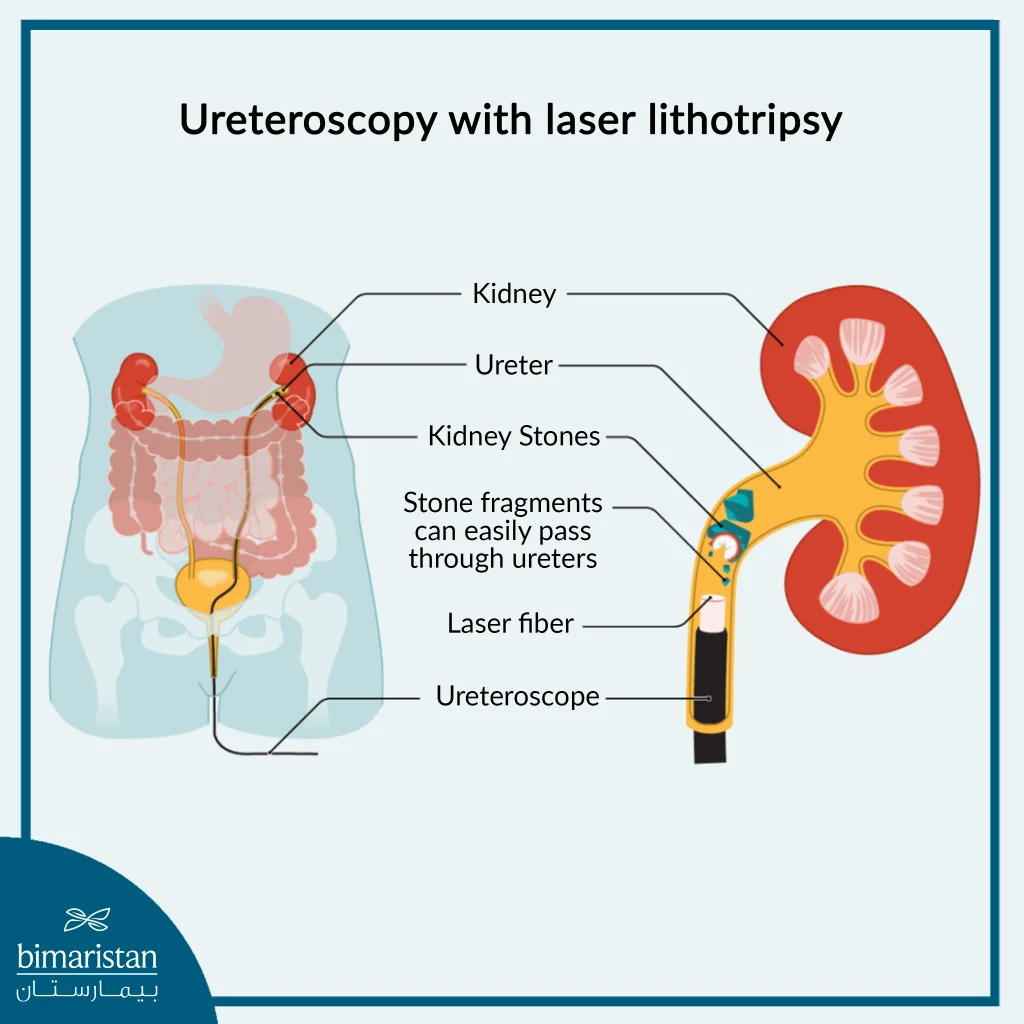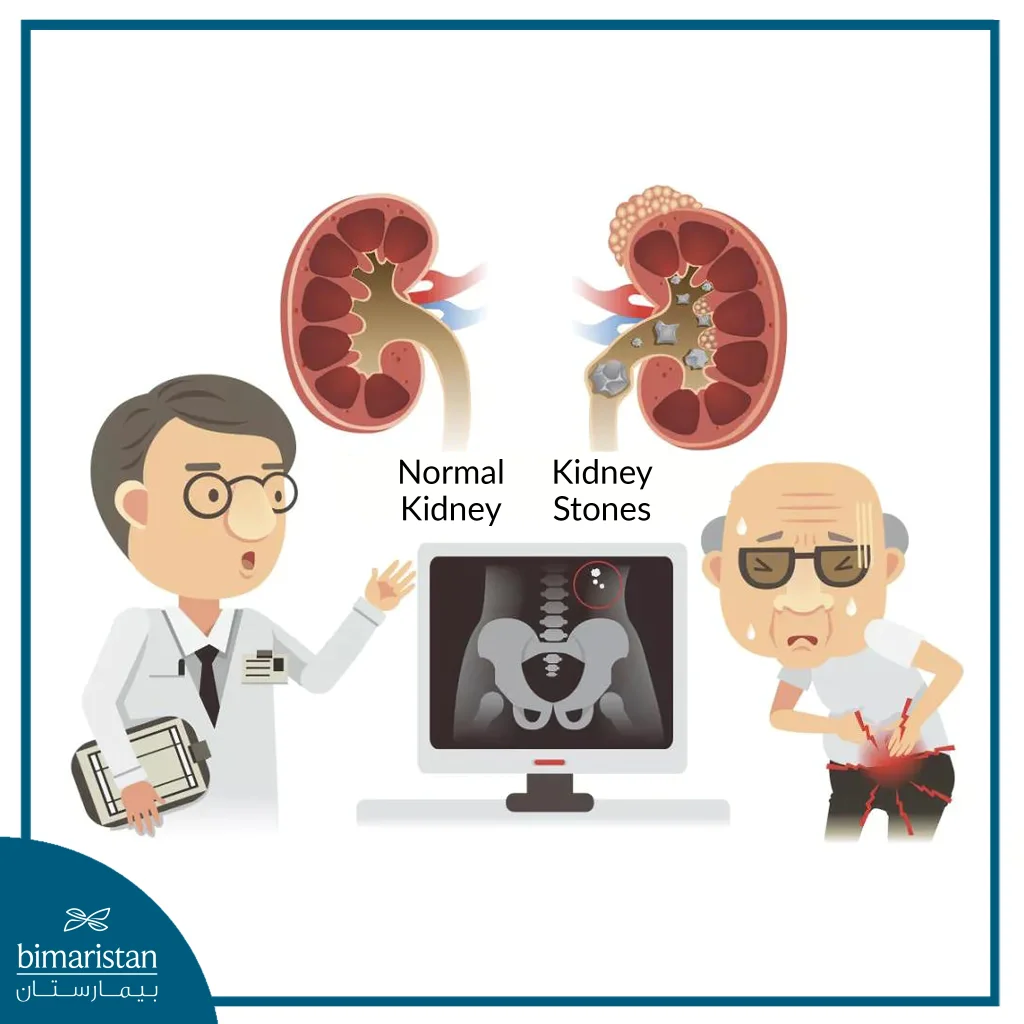Laser lithotripsy has become popular recently for kidney and ureter stone removal, even upping shock wave lithotripsy.
The use of laser for urinary stone fragmentation has gained significant popularity lately. Laser can effectively target large stones without apparent complications or risks, as it is a minimally invasive procedure performed using ureteroscopy without any surgical incisions.
Many studies compare laser lithotripsy with extracorporeal shock wave lithotripsy (ESWL). While both procedures serve the same purpose (stone fragmentation), there are some differences between the two methods. Follow along to learn about the benefits and risks of kidney stone laser lithotripsy and the procedure’s cost in Turkey.
Laser operation for kidney stone (ureteroscopy with laser lithotripsy)
Doctors at a hospital in the United States first used laser lithotripsy in 1980. Since then, this technique has been developed and updated to become more efficient, less risky, and with few side effects.
This procedure involves inserting a device composed of optical fibers capable of generating laser waves into the urinary tract. A ureteroscope equipped with a camera precisely locates the stones for fragmentation. The laser light with specific specifications is directed directly at the stones.
Through this technique, the doctor can fragment kidney, ureter, and bladder stones. After fragmentation, the broken stone particles are collected in a unique basket inserted through the scope and expelled when the patient urinates.
During the laser lithotripsy procedure, which usually takes about half an hour, the patient is either locally anesthetized or given general anesthesia. After the effects of anesthesia wear off, most patients can return home on the same day.
How long does laser lithotripsy take?
Generally, laser lithotripsy for kidney stones takes about 45 minutes to one hour.
However, the procedure time can vary depending on several factors, including:
- Size and Location of the Stone: Larger or deeper stones within the kidney may require more time to treat.
- Type of Laser Used: Different types of lasers are used for lithotripsy, each with its speed for breaking down the stones.
- Surgeon’s Experience: More experienced surgeons tend to perform the procedure more quickly and efficiently.
- Anesthesia: If you are under general anesthesia, additional time will be needed to administer the anesthesia and for you to recover from it after the procedure.

When do we resort to kidney stone laser lithotripsy?
The incidence of urinary tract stones has significantly increased in our current era due to various factors, including the prevalence of obesity and a sedentary lifestyle, in addition to a low-fiber, high-salt diet. While not all stones need to be fragmented, as small stones may pass with urine without causing symptoms, large stones can cause urinary obstruction, severe pain, and potential kidney damage if left untreated.
We resort to laser renal stone fragmentation to treat and fragment stubborn stones that do not respond to medical treatment, especially those challenging to fragment using shock waves due to factors such as their large size, location, or hardness. Laser lithotripsy surgery has proven its effectiveness in treating all types of kidney and urinary stones. You can read more about kidney stone fragmentation using shock waves.
Benefits of Laser Kidney Stone Fragmentation
Laser stone removal offers many benefits and advantages compared to shock wave lithotripsy, making it a preferred procedure. Among these features, we mention:
- Higher success rates
- Better and more effective against large stones
- Preferred for patients with multiple stones
Risks of laser therapy for kidney stone
Laser treatment for kidney stones’ side effects cannot be entirely ruled out, although rare. However, any medical intervention comes with some risks, including in this case:
- Bleeding or increased amount of blood in the urine
- Injury to a part of the urinary tract
- Urinary tract infection due to infection transmission
- Pain and burning sensation during urination
- Need for repeat lithotripsy surgery to remove remaining stones

After the laser lithotripsy procedure
After you wake up from the effects of anesthesia, your doctor will monitor your vital signs, such as heart rate and respiratory rate, to ensure the stability of your health condition without any complications resulting from the procedure and determine your readiness to return home. Your doctor may prescribe some pain relievers and symptom-relieving medications during the recovery period following the holmium laser lithotripsy.
There is no need to worry if you notice blood in your urine in the first few days after the procedure. This is normal as long as the amount of blood is not significant. It may take several weeks for all the tiny stone particles to be removed during urination.
In the days following the procedure, you may also experience back pain, especially around the flank, which is expected and can be alleviated using pain relievers such as ibuprofen. Some people may notice mild redness on the skin around the flanks where the laser was applied.
The patient may need about a week before returning to their usual daily activities. The recovery period may vary depending on each patient’s condition. Your specialist will determine the necessary period of rest and recovery after kidney stone fragmentation surgery.
Symptoms after laser lithotripsy
After undergoing laser lithotripsy for kidney stones, it is expected to experience some symptoms. The most common symptoms include:
- Pain: You may experience pain in the back, side, or abdomen. Your doctor usually prescribes medications to manage this pain.
- Bleeding: After the procedure, some blood might be in your urine. This is usually mild and resolves within a few days.
- Frequent or Painful Urination: You may need to urinate more frequently than usual and may experience burning or discomfort while urinating.
- Nausea or Vomiting: Nausea or vomiting may occur after the procedure, typically subsiding within a day or two.
- Fatigue: Feeling fatigued after the procedure is common and generally resolves within a day or two.
In addition to these common symptoms, you may also experience:
- Fever or Chills: These could be signs of an infection.
- Severe or Persistent Pain in the Back, Side, or Abdomen: This may indicate a blockage in the urinary tract or other complications.
- Difficulty Urinating: This could be a sign of a urinary tract blockage.
- More blood in urine than usual: This might indicate other complications.
It’s essential to contact your doctor immediately if you experience any of these symptoms.
Tips for relieving symptoms after laser lithotripsy
After laser lithotripsy for kidney stones, following your doctor’s instructions carefully is crucial. This will help you recover faster and reduce the risk of complications. Here are some general tips:
- Drink Plenty of Fluids: Drinking lots of fluids helps to pass stone fragments through the urinary tract and reduces the risk of infection. Aim to drink six or more glasses of water daily.
- Take Pain Relievers: Over-the-counter pain relievers like ibuprofen or acetaminophen can help manage pain. Follow your doctor’s dosage and frequency recommendations.
- Apply Warm Compresses: Warm compresses can alleviate pain in the back or side. Apply a warm compress to the affected area for 20 minutes, with 10-minute breaks between each application.
- Take a Warm Bath: A warm bath can help relax your muscles and relieve pain.
- Follow a Digestible Diet: You may want to eat soft, easily digestible foods for a few days after the procedure. Avoid spicy, rich, or acidic foods that may irritate your stomach or contribute to future kidney stones.
- Get Plenty of Rest: Rest is vital for healing your body. Plan to take it easy at home for a few days following the procedure.
- Avoid Strenuous Activity: Do not lift heavy objects or engage in strenuous exercise until your doctor advises otherwise. Intense activity could irritate the urinary tract or cause other complications.
- Monitor Your Urine: Pay attention to the color of your urine. After the procedure, it may be slightly pink or red due to stone fragments. However, if your urine is dark red or contains a lot of blood, contact your doctor.
- Follow a healthy diet to prevent future kidney stones:
- Drink plenty of fluids, especially water.
- Eat a diet rich in fruits and vegetables.
- Reduce intake of salt, red meat, and animal protein.
- Maintain a healthy weight.
- If you have certain medical conditions, such as high blood pressure or diabetes, follow your doctor’s advice to manage them.
Contact your doctor immediately if you experience any of the following symptoms:
- Severe or persistent pain in the back, side, or abdomen
- Difficulty urinating
- More blood in the urine than usual
- Fever or chills
- Persistent nausea or vomiting
- Inability to keep fluids down
Following these tips can help ensure a smooth recovery after laser lithotripsy.
Kidney stone laser treatment cost in Turkey
Laser lithotripsy cost varies depending on the case’s nature and the stones’ number and size. The cost of laser surgery for kidney stones in Turkey ranges from $3400 to $4500 US Dollars, which remains relatively low compared to other countries.
In conclusion, laser lithotripsy is one of the latest surgical procedures to eliminate urinary stones without causing complications or accompanying side effects. Some studies have indicated that this procedure is the most effective in fragmenting large multiple kidney stones with infrequent adverse effects, making it worth considering.
References:
- Ureteroscopy and high-power holmium laser lithotripsy to treat renal stones.
- Laser Lithotripsy Fundamentals: From the Physics to Optimal Fragmentation.
- Basic and advanced technological evolution of laser lithotripsy over the past decade: An educational review by the European Society of Urotechnology Section of the European Association of Urology.
